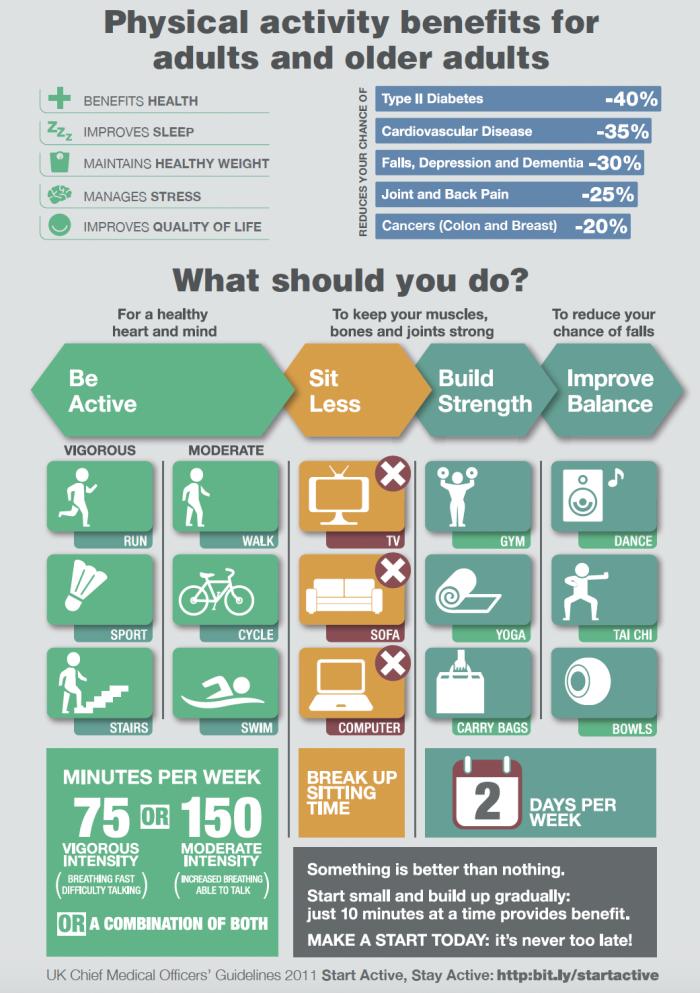Nerve-related arm pain
Dealing with nerve-related arm pain
Being active
Being active can help to reduce neck and nerve-related arm pain. Research has shown that exercise, supports recovery of nerve-related pain and acts as a natural pain reliever. There is no set approach that has been shown to be the best so feel free to try different types of exercise and activity. Be guided by what you enjoy and what you feel able to start. An example may be a brisk walk, a bike ride or an aqua-aerobics class.

Keeping active also means trying to continue, where you can, your normal daily activities including social, work-related and hobbies.
If you are local to Sheffield and you would like support to increase your physical activity, then you can
- Self-refer to Sheffield Physical Activity Referral scheme to access expert and discounted support in physical activity including select gyms across the city.
- Find sport, leisure and activity groups in your local area.
- Visit our page on physical activity under the wider health section of the website for further guidance and support to increase your activity.
Pace the activities or positions which trigger your symptoms
Recognise what may be triggering your symptoms: do not avoid these altogether but instead pace how much you do them. This may include taking regular breaks from an aggravating movement/position or varying your activity frequently to avoid unnecessarily aggravating your arm symptoms.
Your lifestyle
A healthy body = a speedier recovery. Habits like eating a healthy varied diet, low in processed foods, regular activity, stopping smoking (if you currently smoke) and being a healthy weight will optimise your recovery. Lifestyle may need to be considered if pain persists, returns, or different areas are involved. Making small improvements in lifestyle can significantly improve recovery and reduce the likelihood of suffering in the future. See the Wider Health section for more information about healthy living.
Heat or Ice treatment
Heat packs
You may find that applying heat to the sore area helps relieve your pain and any associated muscular tightness or spasm. Use a microwaveable wheat bag or a hot water bottle wrapped in a towel. Keep it on for 15 – 20 minutes, checking your skin regularly to minimise the risk of suffering burn. Repeat 2-3 times per day. Do not place heat on a swollen body part.
Ice packs
This can help to temporarily numb pain. Apply an ice pack (or a bag of frozen vegetables wrapped in a tea towel) to the area for up to 10 minutes, 2-3 times per day.
Pain medication
Taking pain medication may control the pain so that you can keep mobile. Speak to your GP or a pharmacist for further advice.
Further Treatment
Physiotherapy
Not everyone needs to be seen by a physiotherapist. Some people get better on their own, usually when resting is brief, and normal use and activities are resumed. However, some people may need a more tailored programme. The evidence has shown that the best first-line management of nerve-related arm pain is physiotherapy.
Physiotherapy should include active strategies such as targeted and individualised exercises. Treatments like manual therapy, which involves the treatment being done to you, are not effective as a standalone treatment. The time of recovery will vary for each individual depending on their circumstances, but as a rough guide, it can often take at least 3-6 months of consistent rehabilitation before you start to see improvements, so be patient and work with your physiotherapist to get the most from your programme.
Surgery
A very small proportion of people with nerve-related arm pain may be suitable for surgery, however this type of surgery comes with risks and fortunately most people benefit from conservative treatment. Your health care professional can guide you with this option.